Fortresses and forts 🢔 Fortifications 🢔 Archaeological wonders 🢔 Categories of wonders
Wonder
Masada
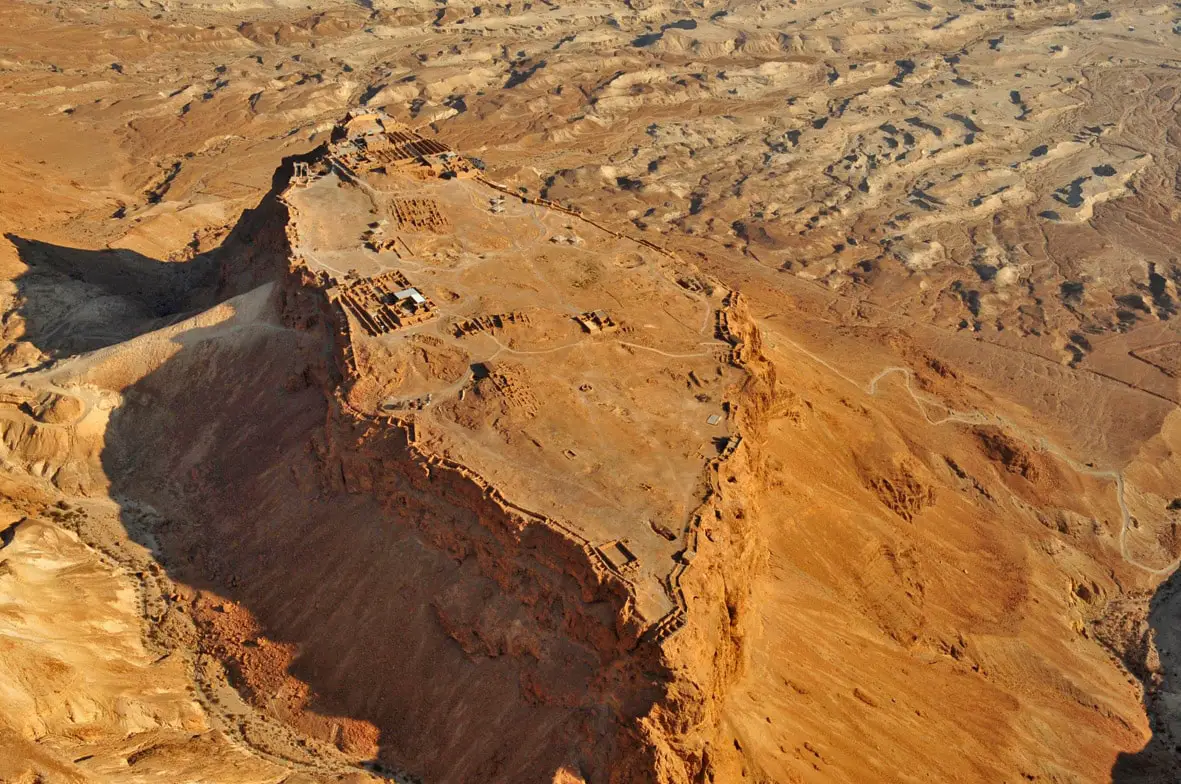
 In short
In short
Best known monument of the Jewish resistance against foreign occupation is Masada – an impressive fortress not far from the Dead Sea. According to ancient writings 960 Jewish people killed themselves here, when Roman army managed to take this fortress in 73 AD.
 61.4%
61.4%
GPS coordinates
Location, address
Name in Hebrew
Alternate names
Culture
Founded
Flourished
UNESCO World Heritage status
Map of the site
If you see this after your page is loaded completely, leafletJS files are missing.
 In detail
In detail
Rock in Judean Desert
Word "Masada" in Hebrew means fortress – and it really looks like it. This rock plateau is located in a deserted place (Judaean Desert) some kilometers from the Dead Sea. All around this archaeological site are deserted lands, almost no people live nearby.
Cliff is well protected by natural precipices around it. On the east edge cliffs and steeps are up to 400 m high but on the west – some 90 m high. The top of the plateau is flat, it is some 550 by 270 m large.
History
Before the King Herod
There is little known about the history of Masada before the 1st century BC. There have been found remnants of a settlement from the 4th millennium BC in a cave near the base of the mountain. First known large fortifications on the top of the plateau were built by the king of Judea Alexander Jannaeus in the early 1st century BC.

Herod the Great
In the power struggle after the death of Alexander Jannaeus a controversial figure – Herod the Great – rose to the power. This Jewish king subdued to the Romans and Judea de facto became a part of the Roman Empire.
King Herod was in Masada since 40 BC and turned it into major fortification – mainly to protect himself from Jewish revolts and possible foreign incursion. Nevertheless, in Herod’s time, it was not just a desert fortress – there was a complex of luxurious buildings, a retreat of tyrant from his own nation similar to King Kasyapa’s Sigiriya in Sri Lanka.
One of Herod’s first works after coming to power was the construction of a water supply system, palace, and fortifications in the fortress. This so-called Western Palace was built soon after 35 BC when three smaller palaces and other buildings were constructed as well. In 25 BC Herod started the second phase of large-scale construction in Masada when Western Palace was extended and Northern Palace was built. Northern Palace was an especially ambitious structure built on the northern ledge of the fortress of Masada with two levels built below the end of the cliff. This enormous structure included also a bathhouse in Roman style.
The third wave of construction activity came at 15 BC when a 1,300 m long and 4 m tall fortification wall with some 30 towers was built around the whole ledge of the fortress. Only the steep precipice at Northern Palace was not reinforced. This enormous fortification was a double-walled structure with casemates inside.
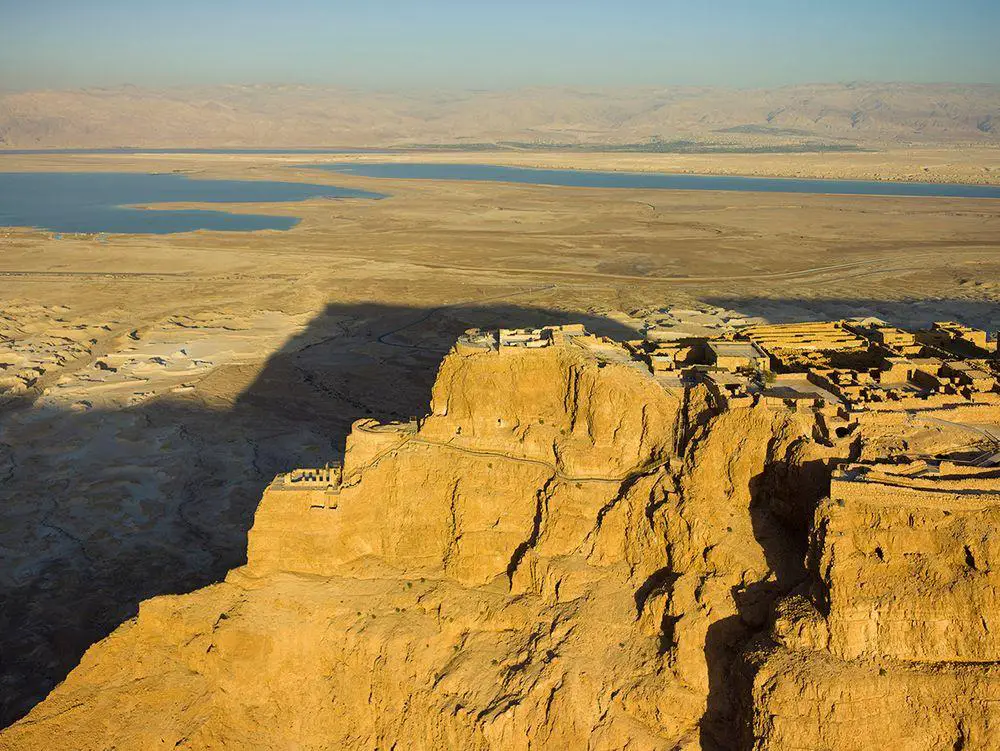
Sicarii and Siege of Masada
Great events took place in the fortress some decades later: in 66 – 73 AD. These events have been described by Jewish Roman historian Titus Flavius Josephus in "The Jewish War". There is no similar alternative work to this great story of antiquity – thus historians had to rely on the viewpoint of Josephus Flavius, although we can not be sure if his interpretation was correct.
Thus, according to Josephus the story of Masada goes as follows:
In the 66 AD Masada was captured by a militant group of Jews named Sicarii (one branch of Zealots), led by Menahem. According to Josephus, this was not a peaceful group at all – they were making raids to nearby settlements and once in the nearby Ein Gedi, they killed some 700 women and children.
Sicarii made further fortifications, they built also residential buildings, synagogue, mikwe (place for ritual baths), cave rooms. These people were not rich and Herod’s luxurious palaces were turned into dwellings of poor families.
Romans decided to put an end to this and organized a military expedition of a Roman army to Masada – the last outpost of Zealots (Jerusalem fell in 70 AD). Roman legion surrounded the mountain in 72 AD and built their own fortifications. A group of Jewish prisoners of war was put at work to build a ramp towards the fortress and the surrounded Sicarii did not attack them. Finally, Romans managed to breach the fortification wall in the spring of 73 AD. They decided to enter the fortification the next day.
According to Josephus, after the night, when Romans entered the fortified plateau, Sicarii (led by Eleazar ben Ja’ir or Ben Yair) set all the buildings in the fortress ablaze, and the remaining 960 people, including women and children decided to commit suicide. At first, men killed their children and women, and then ten men were designated who killed the other men. And finally: one man killed the remaining nine and himself. Only two women and five children hid in a cave and survived to tell the story.
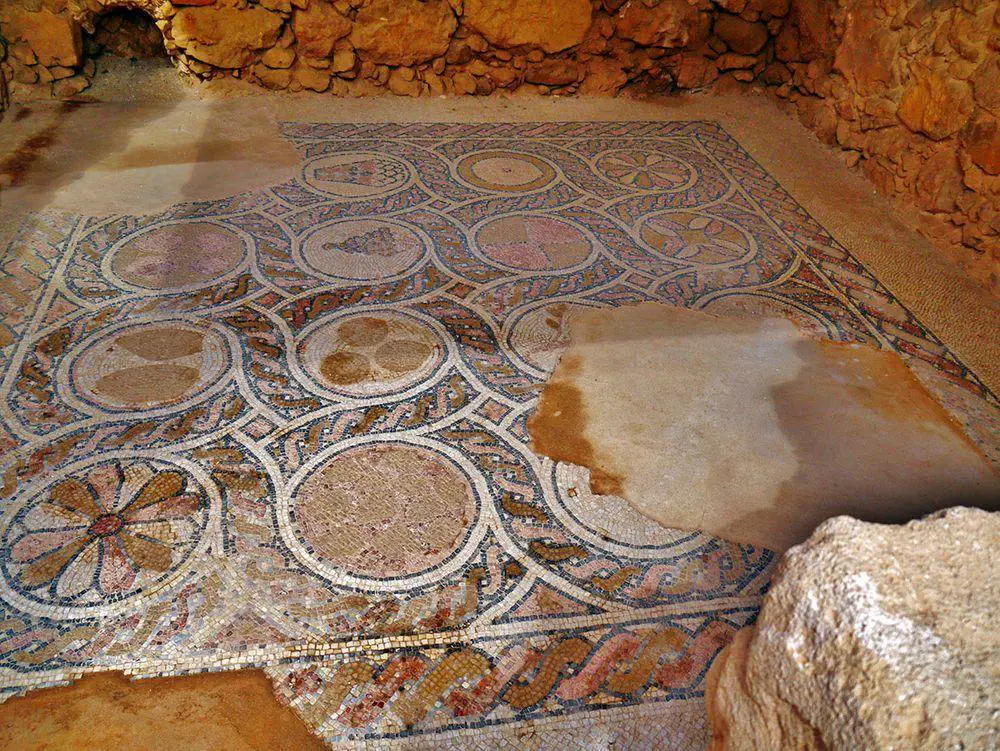
Is the legend true?
Lately several archaeologists have put in doubt the report of Josephus, especially regarding the mass suicide.
There are even doubts about the Roman siege – there is no convincing archaeological evidence for it. This goes in contradiction with the finds of the archaeological research led by Professor Yigael Yadin in 1963. Nevertheless, some contemporary scientists are pointing to the fact that the nationalism in the young nation of Israel to a large extent influenced the outcome of the research: specialists back in 1963 wanted to find the justification for the myth of the siege and to some extent “adjusted” the facts to the myth. An especially detailed review of this tendency has been provided by Nachman Ben-Yehuda in his book “Sacrificing Truth: Archaeology and the Myth of Masada”.
Byzantine times
After the purported Roman siege the fort was not inhabited for several centuries, powerful earthquakes destroyed many structures on the mountain.
Some centuries later the remote mountain with its spooky ruins was inhabited by a group of Christian monks who built a Byzantine church in the 5th or 6th century. Church had a fine mosaic floor but today only a small fragment has survived. The site was inhabited also in the times of the Crusades but afterward, it was abandoned.
Modern times
Solitude far away from other settlements and desert environments helped to save the remaining ruins.
Europeans discovered Masada for themselves in 1838 when Edward Robinson and Eli Smith noticed the impressive mountain from the nearby Ein Gedi.
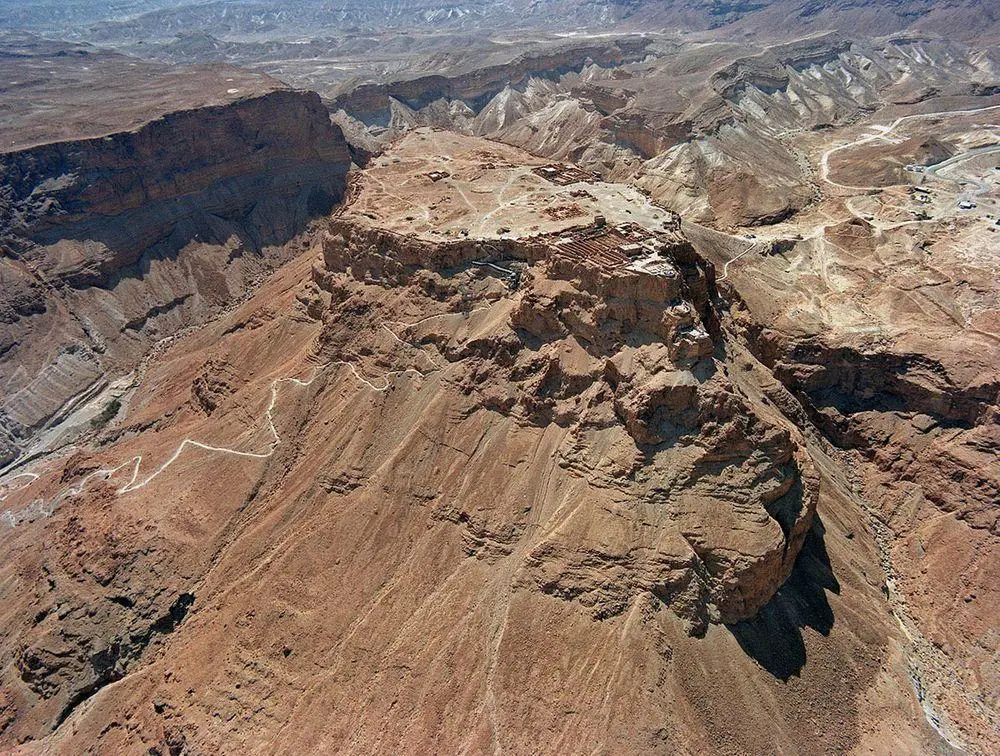
Extensive excavations started here only in 1963-1965 and were led by Yigael Yadin who wrote a great book "Masada" afterward. Here have been found fragments of scrolls with Biblical texts on them. In one of the palaces were found remains of killed people, including children and also captured Roman soldiers.
Since then much has been done: numerous structures have been restored: Roman-style bathhouses built by Herod, synagogue, some houses of Jewish rebels, also frescoes (mainly – imitation of marble) in the two main Herod’s palaces. The buildings in the Roman camp near Masada have also been restored.
Today Masada is a monument of major symbolic significance to Jews and a much-visited tourist attraction. Visitors enter the plateau with a cable car, but they can also ascend Snake Trail (300 m climb) or Roman Ramp.
 Linked articles
Linked articles
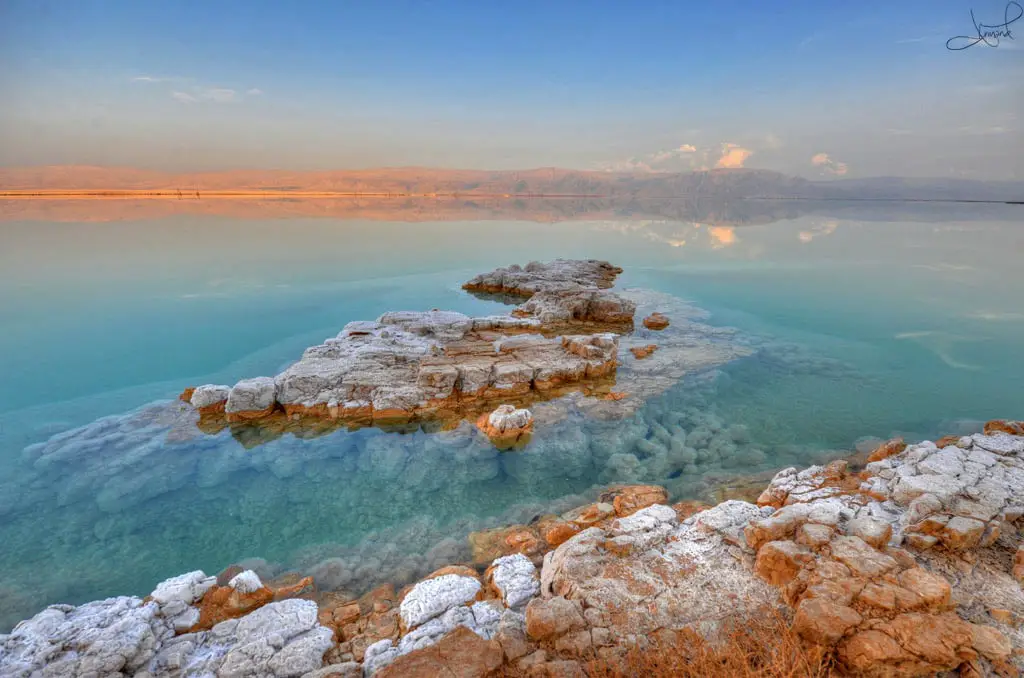
Wonders of Israel
If there is a land at the crossroads of civilizations, then Israel is one. Here from Africa to the remaining world entered different species of humans, including us. The area of Israel was located between the first civilizations in Egypt, Mesopotamia, and Anatolia. The whole country is dotted with monuments of archaeology and history.

Abandoned cities and towns
The main impression created by abandoned cities is intimate. This is a mixed feeling of sadness, unclear anxiety (“my city will not be eternal either”), and at the same time – inspiration from the abilities of our ancestors. Long ago, without electricity, paper, or different mechanisms, they managed to create magnificent structures, that covered many square kilometers.
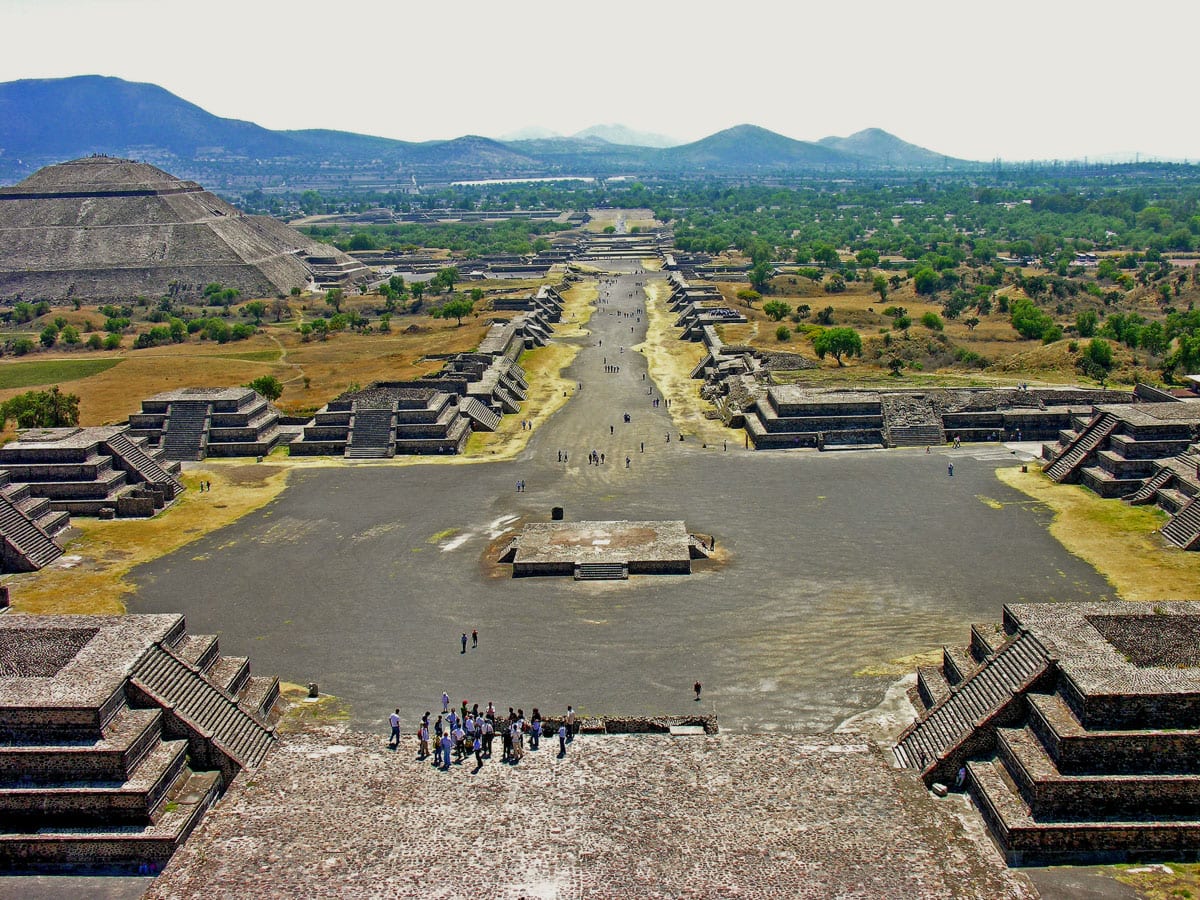
Ancient cities and towns
It turns out that urban planning is a very old profession. The urban fabric of ancient settlements – their structure and evolution gives a lot of food for thoughts about the nature of humans and civilization.
Wondermondo includes in the category of ancient cities and towns those settlements which have developed as urban areas at least 1500 years ago: around 500 AD.
 Recommended books
Recommended books
Masada: The Last Fortress
…Nobody knows exactly what happened or how, of course. We can imagine that the people would have wanted us to know their story. The author takes the facts that we do know and weaves them into a story of the way it might have happened. That is helpful as we weigh those ideas with those of other sources before formulating our own ideas.
The Siege of Masada: A Historical Drama of the Famous Battle Between the Jews and Romans
The Siege of Masada: A Historical Drama of the Famous Battle Between the Jews and Romans is a historical drama that portrays the famous battle from the standpoint of a fictional survivor.


